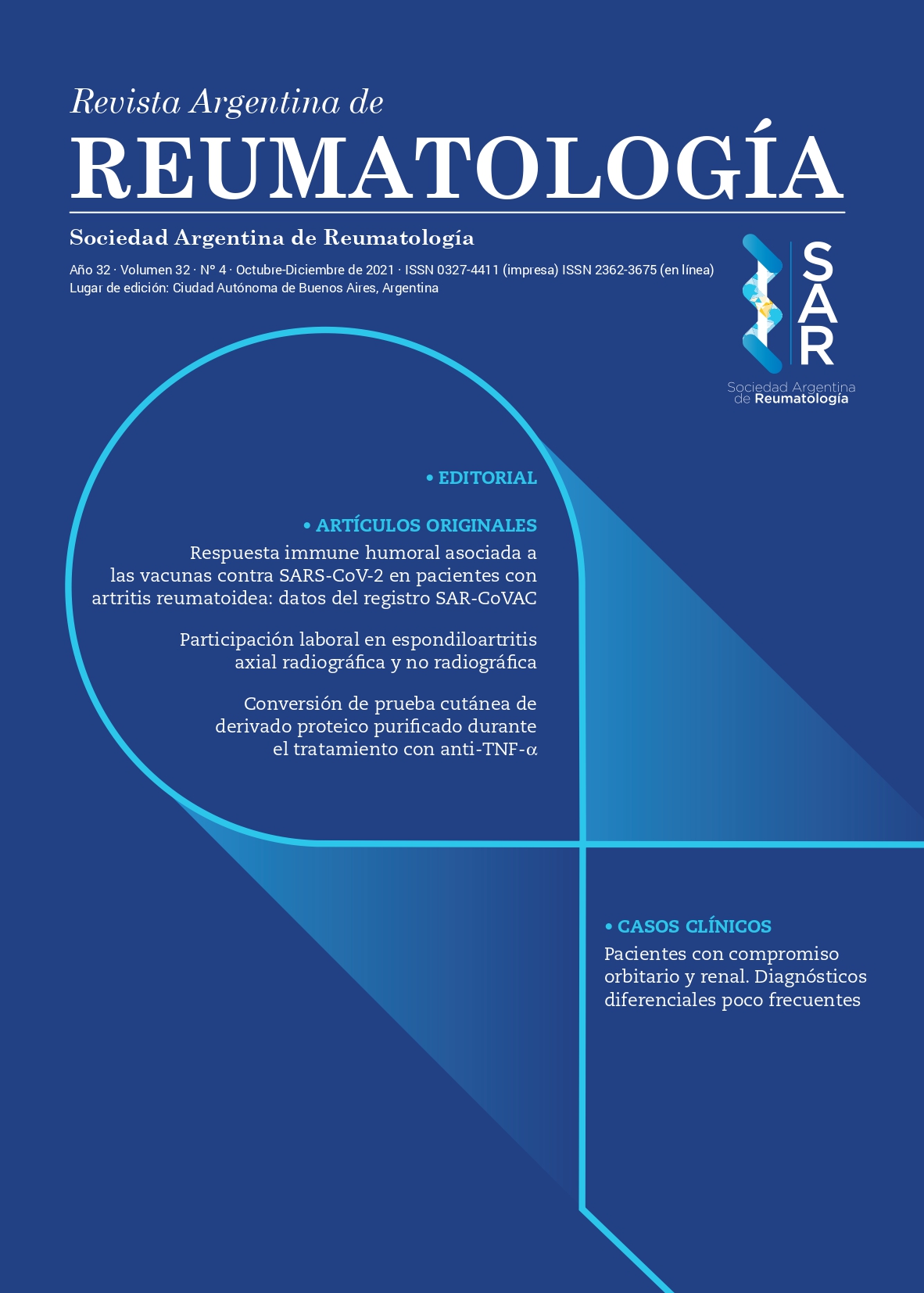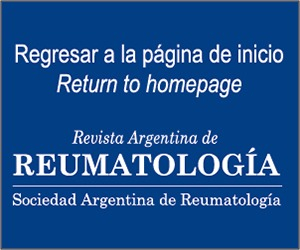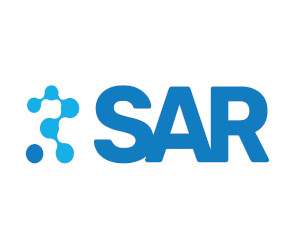Ustekinumab en psoriasis cutánea y artritis psoriásica
Resumen
La artritis psoriásica (APs) es una enfermedad articular inflamatoria crónica, que se ha clasificado dentro del grupo de las espondiloartritis. La psoriasis cutánea afecta alrededor del 2 al 4% de la población general mundial, y entre el 6% y el 42% de los pacientes con psoriasis desarrollarán APs según estudios en distintos lugares del mundo, y el 17% en Argentina, según un estudio desarrollado por Maldonado Ficco y cols3. En nuestro país en la población general, la APs tiene una prevalencia de 74 (IC 95%: 57, 94) casos por 100 000 personas, una incidencia de 6,26; (IC 95: 4,2, 8,3 casos) por 100 000 personas/años. Los datos de prevalencia de APs en pacientes con psoriasis son variables en la literatura, y esto es debido, en parte, a la heterogeneidad de la enfermedad y a los diferentes criterios para definirla. La APs afecta por igual a hombres y mujeres y su incidencia es mayor en adultos entre los 30 y 50 años. El compromiso cutáneo aparece antes del compromiso articular en el 75% de los pacientes con APs, después de la artritis en el 15% y en un 10% de los pacientes, ambas aparecen en forma simultánea.Citas
II. Parisi R, Symmons DP, Griffiths CE, Ashcroft DM. Global epidemiology of psoriasis: a systematic review of incidence and prevalence. The Journal of investigative dermatology. 2013;133(2):377-385.
III. Ficco HM, Citera G, Cocco JA. Prevalence of psoriatic arthritis in psoriasis patients according to newer classification criteria. Clinical rheumatology. 2014;33(10):1489-1493.
IV. Soriano ER, Javier Rosa, Edson Velozo, et al. Incidence and Prevalence of Psoriatic Arthritis (PsA) in a Health Management Organization (HMO) in Argentina. Arthritis and rheumatism. 2006.
V. Shbeeb M, Uramoto KM, Gibson LE, O’Fallon WM, Gabriel SE. The epidemiology of psoriatic arthritis in Olmsted County, Minnesota, USA, 1982-1991. The Journal of rheumatology. 2000;27(5):1247-1250.
VI. Gottlieb A, Korman NJ, Gordon KB, et al. Guidelines of care for the management of psoriasis and psoriatic arthritis: Section 2. Psoriatic arthritis: overview and guidelines of care for treatment with an emphasis on the biologics. Journal of the American Academy of Dermatology. 2008;58(5):851-864.
VII. Goldenstein-Schainberg C, Favarato MH, Ranza R. Current and relevant concepts in psoriatic arthritis. Revista brasileira de reumatologia. 2012;52(1):98-106.
VIII. Taylor W, Gladman D, Helliwell P, Marchesoni A, Mease P, Mielants H. Classification criteria for psoriatic arthritis: development of new criteria from a large international study. Arthritis and rheumatism. 2006;54(8):2665-2673.
IX. Saad AA, Symmons DP, Noyce PR, Ashcroft DM. Risks and benefits of tumor necrosis factoralpha inhibitors in the management of psoriatic arthritis: systematic review and metaanalysis of randomized controlled trials. The Journal of rheumatology. 2008;35(5):883-890.
X. Acosta Felquer ML, Coates LC, Soriano ER, et al. Drug therapies for peripheral joint disease in psoriatic arthritis: a systematic review. The Journal of rheumatology. 2014;41(11):2277-2285.
XI. Soriano ER, McHugh NJ. Therapies for peripheral joint disease in psoriatic arthritis. A systematic review. The Journal of rheumatology. 2006;33(7):1422-1430.
XII. Soriano ER, Rosa J. Update on the treatment of peripheral arthritis in psoriatic arthritis. Current rheumatology reports. 2009;11(4):270-277.
XIII. Soriano ER. The actual role of therapy with traditional disease-modifying antirheumatic drugs in psoriatic arthritis. The Journal of rheumatology. Supplement. 2012;89:67-70.
XIV. Ritchlin CT, Kavanaugh A, Gladman DD, et al. Treatment recommendations for psoriatic arthritis. Annals of the rheumatic diseases. 2009;68(9):1387-1394.
XV. Soriano ER. Treatment guidelines for psoriatic arthritis. International Journal of Clinical Rheumatology. 2009;4:329-342.
XVI. Felquer ML, Soriano ER. New treatment paradigms in psoriatic arthritis: an update on new therapeutics approved by the U.S. Food and Drug Administration. Current opinion in rheumatology. 2015;27(2):99-106.
XVII. Rodgers M, Epstein D, Bojke L, et al. Etanercept, infliximab and adalimumab for the treatment of psoriatic arthritis: a systematic review and economic evaluation. Health Technol Assess. 2011;15(10):i-xxi, 1-329.
XVIII. Langrish CL, McKenzie BS, Wilson NJ, de Waal Malefyt R, Kastelein RA, Cua DJ. IL-12 and IL-23: master regulators of innate and adaptive immunity. Immunol Rev. 2004;202:96-105.
XIX. Di Cesare A, Di Meglio P, Nestle FO. The IL-23/Th17 axis in the immunopathogenesis of psoriasis. The Journal of investigative dermatology. 2009;129(6):1339-1350.
XX. Krueger GG, Langley RG, Leonardi C, et al. A human interleukin-12/23 monoclonal antibody for the treatment of psoriasis. The New England
journal of medicine. 2007;356(6):580-592.
XXI. Davari P, Leo MS, Kamangar F, Fazel N. Ustekinumab for the treatment of psoriatic arthritis: an update. Clinical, cosmetic and investigational dermatology. 2014;7:243-249.
XXII. Murphy KM, Reiner SL. The lineage decisions of helper T cells. Nature reviews. Immunology. 2002;2(12):933-944.
XXIII. Langrish CL, Chen Y, Blumenschein WM, et al. IL-23 drives a pathogenic T cell population that induces autoimmune inflammation. J Exp Med. 2005;201(2):233-240.
XXIV. Lowes MA, Kikuchi T, Fuentes-Duculan J, et al. Psoriasis vulgaris lesions contain discrete populations of Th1 and Th17 T cells. The Journal of investigative dermatology. 2008;128(5):1207-1211.
XXV. Liu Y, Helms C, Liao W, et al. A genome-wide association study of psoriasis and psoriatic arthritis identifies new disease loci. PLoS genetics. 2008;4(3):e1000041.
XXVI. Raychaudhuri SP. Role of IL-17 in psoriasis and psoriatic arthritis. Clinical reviews in allergy & immunology. 2013;44(2):183-193.
XXVII. Zhu YW, Mendelsohn A, Pendley C, Davis HM, Zhou H. Population pharmacokinetics of ustekinumab in patients with active psoriatic arthritis. International journal of clinical pharmacology and therapeutics. 2010;48(12):830-846.
XXVIII. Hsu L, Armstrong AW. Anti-drug antibodies in psoriasis: a critical evaluation of clinical significance and impact on treatment response. Expert review of clinical immunology. 2013;9(10):949-958.
XXIX. Kauffman CL, Aria N, Toichi E, et al. A phase I study evaluating the safety, pharmacokinetics, and clinical response of a human IL-12 p40 antibody in subjects with plaque psoriasis. The Journal of investigative dermatology. 2004;123(6):1037-1044.
XXX. Gottlieb AB, Cooper KD, McCormick TS, et al. A phase 1, double-blind, placebo-controlled study evaluating single subcutaneous administrations of a human interleukin-12/23 monoclonal antibody in subjects with plaque psoriasis. Current medical research and opinion. 2007;23(5):1081-1092.
XXXI. Leonardi CL, Kimball AB, Papp KA, et al. Efficacy and safety of ustekinumab, a human interleukin-12/23 monoclonal antibody, in patients with psoriasis: 76-week results from a randomised, double-blind, placebo-controlled trial
(PHOENIX 1). Lancet. 2008;371(9625):1665-1674.
XXXII. Papp KA, Langley RG, Lebwohl M, et al. Efficacy and safety of ustekinumab, a human interleukin-12/23 monoclonal antibody, in patients with psoriasis: 52-week results from a randomised, double-blind, placebo-controlled trial (PHOENIX 2). Lancet. 2008;371(9625):1675-1684.
XXXIII. Griffiths CE, Strober BE, van de Kerkhof P, et al. Comparison of ustekinumab and etanercept for moderate-to-severe psoriasis. The New England journal of medicine. 2010;362(2):118-128.
XXXIV. Tsai TF, Ho JC, Song M, et al. Efficacy and safety of ustekinumab for the treatment of moderate-to-severe psoriasis: a phase III, randomized,
placebo-controlled trial in Taiwanese and Korean patients (PEARL). Journal of dermatological science. 2011;63(3):154-163.
XXXV. Gottlieb A, Menter A, Mendelsohn A, et al. Ustekinumab, a human interleukin 12/23 monoclonal antibody, for psoriatic arthritis: randomised, double-blind, placebo-controlled, crossover trial. Lancet. 2009;373(9664):633-640.
XXXVI. McInnes IB, Kavanaugh A, Gottlieb AB, et al. Efficacy and safety of ustekinumab in patients with active psoriatic arthritis: 1 year results of the phase 3, multicentre, double-blind, placebo-controlled PSUMMIT 1 trial. Lancet. 2013;382(9894):780-789.
XXXVII. Ritchlin C, Rahman P, Kavanaugh A, et al. Efficacy and safety of the anti-IL-12/23 p40 monoclonal antibody, ustekinumab, in patients with active psoriatic arthritis despite conventional non-biological and biological anti-tumour necrosis factor therapy: 6-month and 1-year results of the phase 3, multicentre, double-blind, placebo-controlled, randomised PSUMMIT 2 trial. Annals of the rheumatic diseases. 2014;73(6):990-999.
XXXVIII. Kavanaugh A, Ritchlin C, Rahman P, et al. Ustekinumab, an anti-IL-12/23 p40 monoclonal antibody, inhibits radiographic progression in patients with active psoriatic arthritis: results of an integrated analysis of radiographic data from the phase 3, multicentre, randomised, double-blind, placebo-controlled PSUMMIT-1 and PSUMMIT-2 trials. Annals of the rheumatic diseases. 2014;73(6):1000-1006.
XXXIX. Papp KA, Griffiths CE, Gordon K, et al. Longterm safety of ustekinumab in patients with moderate-to-severe psoriasis: final results from 5 years of follow-up. The British journal of dermatology. 2013;168(4):844-854.
Derechos de autor 2015 A nombre de los autores. Derechos de reproducción: Sociedad Argentina de Reumatología

Esta obra está bajo licencia internacional Creative Commons Reconocimiento-NoComercial-SinObrasDerivadas 4.0.






